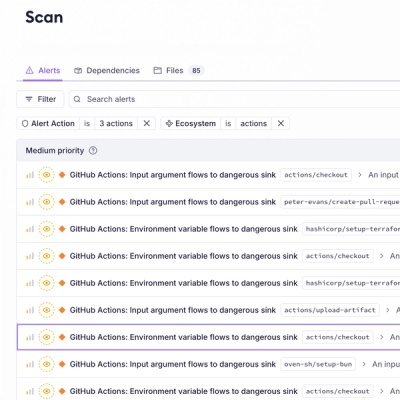
Product
Introducing Socket Firewall Enterprise: Flexible, Configurable Protection for Modern Package Ecosystems
Socket Firewall Enterprise is now available with flexible deployment, configurable policies, and expanded language support.
@mozilla/jest-environment-puppeteer
Advanced tools
Run your tests using Jest & Puppeteer 🎪✨
npm install jest-environment-puppeteer puppeteer
Update your Jest configuration:
{
"globalSetup": "jest-environment-puppeteer/setup",
"globalTeardown": "jest-environment-puppeteer/teardown",
"testEnvironment": "jest-environment-puppeteer"
}
Use Puppeteer in your tests:
describe('Google', () => {
beforeAll(async () => {
await page.goto('https://google.com')
})
it('should display "google" text on page', async () => {
const text = await page.evaluate(() => document.body.textContent)
expect(text).toContain('google')
})
})
global.browserGive access to the Puppeteer Browser.
it('should open a new page', async () => {
const page = await browser.newPage()
await page.goto('https://google.com')
})
global.pageGive access to a Puppeteer Page opened at start (you will use it most of time).
it('should fill an input', async () => {
await page.type('#myinput', 'Hello')
})
global.contextGive access to a browser context that is instantiated when the browser is launched. You can control whether each test has its own isolated browser context using the browserContext option in your jest-puppeteer.config.js.
global.jestPuppeteer.debug()Put test in debug mode.
debugger instruction to Chromium, if Puppeteer has been launched with { devtools: true } it will stopit('should put test in debug mode', async () => {
await jestPuppeteer.debug()
})
global.jestPuppeteer.resetPage()Reset global.page
beforeEach(async () => {
await jestPuppeteer.resetPage()
})
global.jestPuppeteer.resetBrowser()Reset global.browser, global.context, and global.page
beforeEach(async () => {
await jestPuppeteer.resetBrowser()
})
jest-puppeteer.config.jsYou can specify a jest-puppeteer.config.js at the root of the project or define a custom path using JEST_PUPPETEER_CONFIG environment variable. It should export a config object or a Promise for a config object.
launch <[object]> All Puppeteer launch options can be specified in config. Since it is JavaScript, you can use all stuff you need, including environment.connect <[object]> All Puppeteer connect options can be specified in config. This is an alternative to launch config, allowing you to connect to an already running instance of Chrome.browserContext <[string]>. By default, the browser context (cookies, localStorage, etc) is shared between all tests. The following options are available for browserContext:
default Each test starts a tab, so all tests share the same context.incognito Each tests starts an incognito window, so all tests have a separate, isolated context. Useful when running tests that could interfere with one another. (Example: testing multiple users on the same app at once with login, transactions, etc.)exitOnPageError <[boolean]> Exits page on any global error message thrown. Defaults to true.server <[Object]> Server options allowed by jest-dev-server// jest-puppeteer.config.js
module.exports = {
launch: {
dumpio: true,
headless: process.env.HEADLESS !== 'false',
},
server: {
command: 'node server.js',
port: 4444,
launchTimeout: 10000,
debug: true,
},
}
This example uses an already running instance of Chrome by passing the active web socket endpoint to connect. This is useful, for example, when you want to connect to Chrome running in the cloud.
// jest-puppeteer.config.js
const fetch = require('node-fetch')
const dockerHost = 'http://localhost:9222'
async function getConfig() {
const response = await fetch(`${dockerHost}/json/version`)
const browserWSEndpoint = (await response.json()).webSocketDebuggerUrl
return {
connect: {
browserWSEndpoint,
},
server: {
command: 'node server.js',
port: 3000,
launchTimeout: 10000,
debug: true,
},
}
}
module.exports = getConfig()
Thanks to Fumihiro Xue for his great Jest example.
MIT
FAQs
Puppeteer environment for Jest.
The npm package @mozilla/jest-environment-puppeteer receives a total of 4 weekly downloads. As such, @mozilla/jest-environment-puppeteer popularity was classified as not popular.
We found that @mozilla/jest-environment-puppeteer demonstrated a not healthy version release cadence and project activity because the last version was released a year ago. It has 6 open source maintainers collaborating on the project.
Did you know?

Socket for GitHub automatically highlights issues in each pull request and monitors the health of all your open source dependencies. Discover the contents of your packages and block harmful activity before you install or update your dependencies.

Product
Socket Firewall Enterprise is now available with flexible deployment, configurable policies, and expanded language support.

Security News
Open source dashboard CNAPulse tracks CVE Numbering Authorities’ publishing activity, highlighting trends and transparency across the CVE ecosystem.

Product
Detect malware, unsafe data flows, and license issues in GitHub Actions with Socket’s new workflow scanning support.